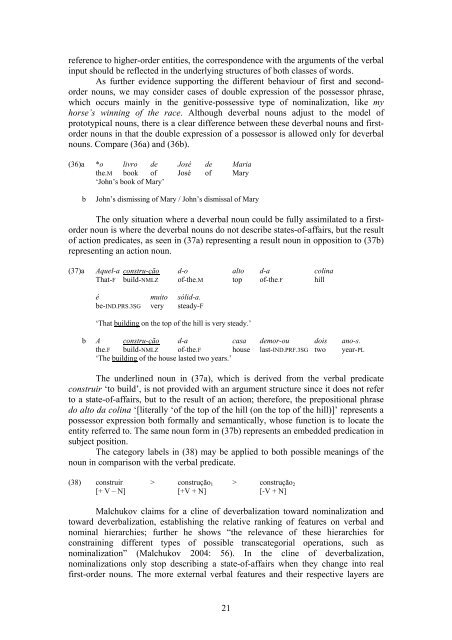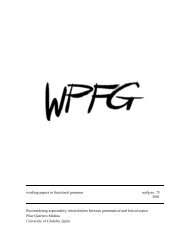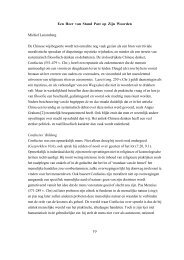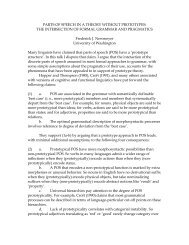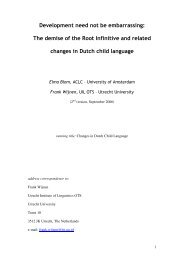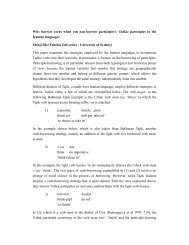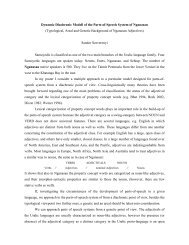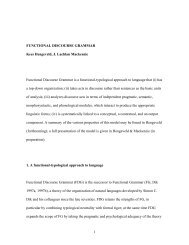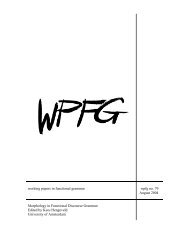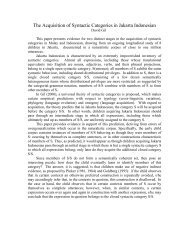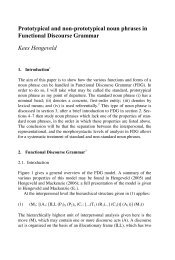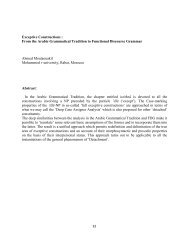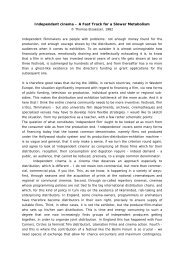The argument structure of deverbal nouns in Brazilian Portuguese
The argument structure of deverbal nouns in Brazilian Portuguese
The argument structure of deverbal nouns in Brazilian Portuguese
You also want an ePaper? Increase the reach of your titles
YUMPU automatically turns print PDFs into web optimized ePapers that Google loves.
eference to higher-order entities, the correspondence with the <strong>argument</strong>s <strong>of</strong> the verbal<br />
<strong>in</strong>put should be reflected <strong>in</strong> the underly<strong>in</strong>g <strong>structure</strong>s <strong>of</strong> both classes <strong>of</strong> words.<br />
As further evidence support<strong>in</strong>g the different behaviour <strong>of</strong> first and secondorder<br />
<strong>nouns</strong>, we may consider cases <strong>of</strong> double expression <strong>of</strong> the possessor phrase,<br />
which occurs ma<strong>in</strong>ly <strong>in</strong> the genitive-possessive type <strong>of</strong> nom<strong>in</strong>alization, like my<br />
horse’s w<strong>in</strong>n<strong>in</strong>g <strong>of</strong> the race. Although <strong>deverbal</strong> <strong>nouns</strong> adjust to the model <strong>of</strong><br />
prototypical <strong>nouns</strong>, there is a clear difference between these <strong>deverbal</strong> <strong>nouns</strong> and firstorder<br />
<strong>nouns</strong> <strong>in</strong> that the double expression <strong>of</strong> a possessor is allowed only for <strong>deverbal</strong><br />
<strong>nouns</strong>. Compare (36a) and (36b).<br />
(36)a *o livro de José de Maria<br />
the.M book <strong>of</strong> José <strong>of</strong> Mary<br />
‘John’s book <strong>of</strong> Mary’<br />
b John’s dismiss<strong>in</strong>g <strong>of</strong> Mary / John’s dismissal <strong>of</strong> Mary<br />
<strong>The</strong> only situation where a <strong>deverbal</strong> noun could be fully assimilated to a firstorder<br />
noun is where the <strong>deverbal</strong> <strong>nouns</strong> do not describe states-<strong>of</strong>-affairs, but the result<br />
<strong>of</strong> action predicates, as seen <strong>in</strong> (37a) represent<strong>in</strong>g a result noun <strong>in</strong> opposition to (37b)<br />
represent<strong>in</strong>g an action noun.<br />
(37)a Aquel-a constru-ção d-o alto d-a col<strong>in</strong>a<br />
That-F build-NMLZ <strong>of</strong>-the.M top <strong>of</strong>-the.F hill<br />
é muito sólid-a.<br />
be-IND.PRS.3SG very steady-F<br />
‘That build<strong>in</strong>g on the top <strong>of</strong> the hill is very steady.’<br />
b A constru-ção d-a casa demor-ou dois ano-s.<br />
the.F build-NMLZ <strong>of</strong>-the.F house last-IND.PRF.3SG two year-PL<br />
‘<strong>The</strong> build<strong>in</strong>g <strong>of</strong> the house lasted two years.’<br />
<strong>The</strong> underl<strong>in</strong>ed noun <strong>in</strong> (37a), which is derived from the verbal predicate<br />
construir ‘to build’, is not provided with an <strong>argument</strong> <strong>structure</strong> s<strong>in</strong>ce it does not refer<br />
to a state-<strong>of</strong>-affairs, but to the result <strong>of</strong> an action; therefore, the prepositional phrase<br />
do alto da col<strong>in</strong>a ‘[literally ‘<strong>of</strong> the top <strong>of</strong> the hill (on the top <strong>of</strong> the hill)]’ represents a<br />
possessor expression both formally and semantically, whose function is to locate the<br />
entity referred to. <strong>The</strong> same noun form <strong>in</strong> (37b) represents an embedded predication <strong>in</strong><br />
subject position.<br />
<strong>The</strong> category labels <strong>in</strong> (38) may be applied to both possible mean<strong>in</strong>gs <strong>of</strong> the<br />
noun <strong>in</strong> comparison with the verbal predicate.<br />
(38) construir > construção1 > construção2<br />
[+ V – N] [+V + N] [-V + N]<br />
Malchukov claims for a cl<strong>in</strong>e <strong>of</strong> <strong>deverbal</strong>ization toward nom<strong>in</strong>alization and<br />
toward <strong>deverbal</strong>ization, establish<strong>in</strong>g the relative rank<strong>in</strong>g <strong>of</strong> features on verbal and<br />
nom<strong>in</strong>al hierarchies; further he shows “the relevance <strong>of</strong> these hierarchies for<br />
constra<strong>in</strong><strong>in</strong>g different types <strong>of</strong> possible transcategorial operations, such as<br />
nom<strong>in</strong>alization” (Malchukov 2004: 56). In the cl<strong>in</strong>e <strong>of</strong> <strong>deverbal</strong>ization,<br />
nom<strong>in</strong>alizations only stop describ<strong>in</strong>g a state-<strong>of</strong>-affairs when they change <strong>in</strong>to real<br />
first-order <strong>nouns</strong>. <strong>The</strong> more external verbal features and their respective layers are<br />
21


